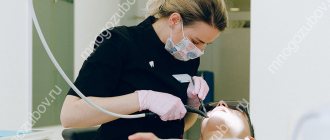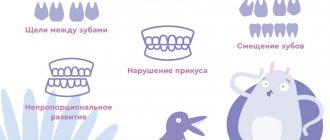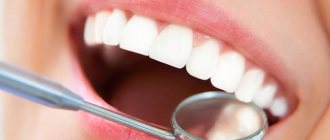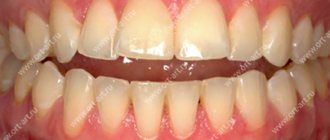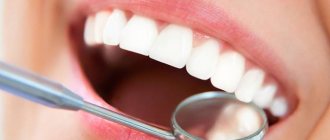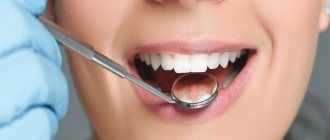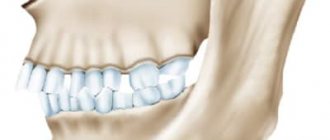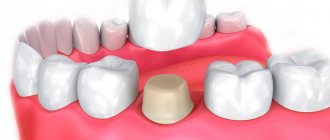27848
A beautiful smile is something that many people dream of for many years, or even their entire adult life.
However, the cost of correcting malocclusion using braces may exceed the financial capabilities of many patients.
The article will provide examples of the possibility of free bite correction, as well as methods of treatment at minimal cost.
The reality of free installation
It should be noted right away that bite correction is not included in the health insurance policy in the Russian Federation.
Accordingly, neither adults nor children have the right to free installation of braces or visits to the orthodontist.
There are, however, several exceptions to this statement. First of all, these are children from privileged categories of the population:
- orphans;
- children with congenital jaw pathology;
- disabled children.
In addition, free installation of braces can be carried out in cases where the patient’s bite pathology appeared as a result of a medical error.
However, it is difficult to call this procedure completely free - the fact of damage as a result of the doctor’s action or inaction will have to be proven in court, and therefore, the costs of litigation will have to be borne.
Public people can also count on free installation of braces. If the patient is the face of a large company or brand, then the employer whose interests he represents may well act as a sponsor for the procedure to correct the bite.
If the patient does not fall into any of the above categories, do not despair.
Installing braces for free or at minimal cost is still possible, however, this will require some effort.
Types of braces offered by Ormco and their features.
Take a closer look at the models of braces systems from American Orthodontics.
At this address https://orto-info.ru/sistemyi-vyiravnivaniya-zubov/breketyi/kley-ot-chego-zavisit-fiksatsii.html we’ll talk about the quality of modern glue for fixing braces.
Orthodontic services under the compulsory medical insurance policy for children
Children are the majority of orthodontic patients, since bite problems most often arise in childhood. What free services can you count on?
Related article: Features of compulsory health insurance at AlfaStrakhovanie-OMS
The list of free services for children within the framework of compulsory medical insurance includes:
- orthodontist appointment;
- correction of bite using orthodontic plates;
- removable prosthetics;
- massage;
- repair and correction of orthodontic plates;
- Help with painful teething in babies.
It should be noted that the plates are made only from domestic material. The installation of imported dental structures is not provided for under compulsory medical insurance.
It is necessary to correct the bite in children as early as possible. Then it is possible to do without braces and use the services of an orthodontist under the compulsory medical insurance program.
Possibility of minimal spending
There are several ways to correct your bite with minimal investment in treatment. In this case, the direction of searches should be turned from public to private clinics.
It is there that there are various options for paying for treatment at a price significantly lower than the fixed one:
- The first way to save is through profitable promotions.
Regarding braces, there is a widespread practice of holding a promotion, during which the client pays in full for the bite correction course, and receives the brace system itself for free. The total cost of treatment becomes less by a third, or even half of the total amount. - Another way is to test new products.
Such chances don’t come along very often, and in order not to miss them, you will have to very carefully follow the news from various clinics and manufacturers. The idea is that the manufacturer recruits a group of volunteers to test new products.Since the procedure is associated with certain risks, testing the product is absolutely free for the patient.
In addition, in the event of the development of adverse symptoms and poor-quality treatment, the brand may not bear any responsibility. Also, the patient will have to visit the doctor more often than usual so that he can compile reports on the progress of testing the product.
- Another way, similar to the previous option, is to participate in testing new batches of goods for the clinic.
In this case, we are talking about the fact that a manufacturer has been producing a product that has passed testing for a long time, but a clinic has only recently signed a contract to cooperate with it.The patient is given either a significant discount or free braces, but with payment for installation and maintenance during treatment. In any case, such chances also come infrequently and require careful monitoring of various social networks, etc.
- Another common way to save is by having savings and bonus systems.
This practice exists in many private dental clinics. If you have been a client of a clinic for a long time, you can enjoy large discounts and sometimes even free services.Some clinics issue unnamed discount cards, so you can use one that belongs to a friend or relative.
In public clinics, as a rule, there is no such practice of rewarding regular clients. At the same time, prices for treatment may be slightly lower, however, the choice of products and additional services there is usually small.
The video provides additional information on the topic of the article.
Mandatory expenses
Despite the fact that the above were ways to save money and even get braces for free, a patient who wants to correct his bite still faces mandatory expenses prior to the installation procedure.
First of all, this is payment for the initial consultation of the orthodontist. At the initial consultation, the oral cavity is examined and a treatment strategy is drawn up - the type of bite and problematic dental units whose position needs to be changed are determined.
During the initial consultation, the orthodontist invites the patient to choose a specific type of braces system, taking into account his wishes and financial capabilities, and, if possible, offers alternative treatment methods.
After the doctor has established the need for treatment, the diagnostic stage . An x-ray is taken to better understand the position of the teeth and the structure of the jaws. If necessary, the doctor prescribes a number of other tests (in particular, if the patient has inflammatory processes or other diseases of the oral cavity).
It should be kept in mind that braces can only be installed on healthy teeth.
Therefore, if the patient has carious cavities, inflammation of soft or bone tissue, then all these diseases must first be cured.
Also, based on preliminary diagnosis, the doctor may decide to remove some dental units (for example, if the patient has a small jaw, but large teeth - when correcting the bite in such a situation, some dental units simply will not be able to “fall into place”).
To properly install the system, an impression is taken from the patient’s jaw and a plaster model is made to understand the required angle and force of impact. Immediately before installation, the patient needs to undergo hygienic cleaning of the oral cavity .
During treatment, the patient will also need to visit the doctor several times to adjust the teeth alignment process and prevent possible complications.
When using self-ligating braces, such visits occur a little less often, and with ligature braces - a little more often.
Objective reviews about braces and the consequences of wearing them.
In this publication we will talk about the indications for the installation of orthoimplants.
Follow the link https://orto-info.ru/sistemyi-vyiravnivaniya-zubov/breketyi/kak-privyiknut-sovetyi.html if you are interested in what the period of getting used to braces depends on.
Information about the provision of medical care under compulsory medical insurance at the Bakulev Center
How to get a referral for VMP
The attending physician of the clinic , in which the patient receives medical care as part of the provision of primary specialized health care and (or) specialized medical care, determines the indications for receiving VMP .
The presence of medical indications for the provision of VMP is confirmed by the decision of the medical commission . The decision of the commission is documented in the Protocol and entered into the patient’s medical documentation.
Medical indications for referral for the provision of high-tech medical care are the presence of a disease and (or) condition in the patient that requires the use of high-tech medical care in accordance with the list of types of high-tech medical care.
If there are medical indications for the provision of high-tech medical care, the attending physician of the referring medical organization issues a Referral for hospitalization for the provision of high-tech medical care.
The following documents are attached to the referral for hospitalization for the provision of medical treatment:
- Extract from the patient's medical records . The extract must contain: information about the patient’s health status, the examination and treatment performed, recommendations on the need to provide VMP, the results of clinical diagnostic studies on the profile of the patient’s disease, carried out in preparing the patient for referral to medical institutions for the purpose of providing VMP.
- Copies of documents:
- Identity document
- Patient's compulsory medical insurance policy
- Insurance number of a citizen’s personal account in the compulsory pension insurance system (SNILS)
Patient's birth certificate (for children aged 14 years)
The patient (his legal representative) has the right to independently apply with a set of documents to the Health Administration Authority (if VMP is not included in the basic compulsory medical insurance program) or to the medical organization receiving him (if VMP is included in the basic compulsory medical insurance program).
Based on this set of documents, the Health Management Authority (HMA) issues a Referral Coupon in electronic form in the information system of the Russian Ministry of Health.
Within 10 working days, the documentation attached to the Coupon is reviewed by doctors at the Bakulev Center. As a result, the Commission for the selection of patients for the provision of high-tech medical care issues an opinion, formalized by the Protocol.
- If the Commission's decision is positive, a date for hospitalization of the patient is set. If there is a waiting list for hospitalization at a medical institution, the patient is placed on a waiting list.
- In the absence of medical indications for the provision of VMP, a refusal is issued, accompanied by recommendations for further observation and (or) treatment of the patient according to the profile of his disease.
- If it is impossible to make a decision on the indications and there are no contraindications to VMP without additional diagnostic measures, the commission returns the patient’s documents to the OHC indicating the required scope of additional examination.
- If there are medical indications for referring the patient to another medical organization, a Conclusion is drawn up indicating the medical organization to which it is recommended to refer the patient.
Nuances of saving
There are some principles that will allow the patient to save some money on installing braces:
- Search for dental clinics that have only recently started operating.
Such centers, as a rule, organize various promotions, provide free diagnostics, and also offer their first customers a discount card. This policy allows newly opened clinics to quickly gain a client base. - Another way is to look for advertisements for promotions and coupons.
If the patient has a particular clinic in mind, you can follow them on social networks. They usually publish the latest information about discounts, as well as partner promotions. - It is also worth keeping in mind that saving means choosing cheaper materials.
Regarding braces, it will cost significantly less to install models made of non-precious alloys than samples made of titanium, sapphire or ceramics. - The type of braces also significantly affects the final cost of treatment.
Vestibular models, which we are used to thinking of when we hear the word “braces,” will cost the patient much less than lingual models, which are worn hidden, since they are located on the lingual part of the dentition.

